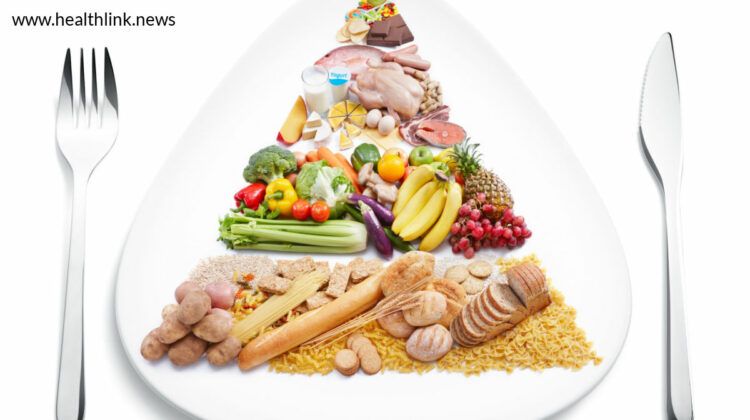Food Pyramid: What You Should Be Eating?

The food pyramid design has been familiar to generations of Americans, and it is here to stay. The Healthy Eating Pyramid, Healthy Eating Plate, and Kid’s Healthy Eating Plate all work best together.
The Healthy Eating Pyramid can be compared to a grocery list for consumers:
Every week, the grocery list should include fruits, vegetables, whole grains, healthy fats, and lean proteins like nuts, beans, fish, and poultry. If desired, it can also include a small amount of yogurt or other dairy products.
The Healthy Eating Pyramid is a helpful resource for health professionals and health educators because it also tackles other facets of healthy living, such as exercise, weight management, vitamin D and multivitamin supplements, and drinking alcohol in moderation for those who drink. The best nutritional advice currently available is condensed in the Healthy Eating Plate and its associated Healthy Eating Pyramid. However, they are not fixed in stone because future nutrition research will produce fresh findings. Important new data will be incorporated into the Healthy Eating Pyramid and the Healthy Eating Plate.
Healthy eating for food pyramid:
You will get all the fiber, vital fatty acids, vitamins, and minerals you require if you fill your plate with foods that are high in nutrition yet low in calories. Additionally, you could discover that you can stay full with fewer calories. An example of a 2,000-calorie diet plan’s food items are as follows:
First day
Breakfast:
- breakfast burrito with heat (tortilla, scrambled egg, black beans, and salsa)
- Orange juice, 1 cup
- 1 cup of milk without fat
Lunch:
- a roast beef or chicken sandwich on whole-grain bread, a “deli special” (with lettuce, sauteed mushrooms, part-skim mozzarella, and yellow mustard)
- 3/4 cup wedges of baked potatoes
Dinner:
- Packed with bread crumbs, celery, and onions, this 5-ounce grilled fish dish is served with rice and slivered almonds.
- a half-cup of steaming broccoli
- 1 cup of milk without fat
Snacks:
- 1 cantaloupe cup
Second day
Breakfast:
- Fat-free milk and raisins on cold cereal
- 1 little banana
- a piece of whole-wheat bread with butter or jam
Lunch:
- whole-wheat pita bread with smoked turkey (with romaine lettuce, tomato slices, salad dressing, and mustard)
- a half-cup of apple slices
- tomato juice, one cup
Dinner:
- grilled 5-ounce prime loin steak
- 1 cup of mashed potatoes
- 1/2 cup of honey-glazed steaming carrots
- dinner roll made of whole wheat
- 1 cup of milk without fat
Snacks:
- 1 cup of fruit and low-fat yogurt
The third day
Breakfast:
- oatmeal cooked with raisins and margarine for breakfas
- a half-cup of fat-free milk
- orange juice, 1 cup
Lunch:
- taco salad from “South of the Border” for lunch (tortilla chips, ground turkey, black beans, iceberg lettuce, tomato slices, low-fat cheddar, salsa, avocado and lime juice)
- 1 drink without sugar
Dinner:
- it will be spinach lasagna with mozzarella and ricotta cheese.
- dinner roll made of whole wheat
- milk without fat, one cup
Snack:
- 1/2 ounce of dry-roasted almonds as a snack
- 14 cups of pineapple
- 2 teaspoons of raisins
The day four
breakfast:
- Breakfast on day four was three buckwheat pancakes with margarine and maple syrup.
- half a cup of strawberries
- Honeydew melon, 3/4 cup
- a half-cup of fat-free milk
Lunch:
- Manhattan clam chowder
- 10 crackers made of whole wheat
- 1 small orange
- 1 cup of milk without fat
Dinner:
- Asian stir-fry of vegetables (with tofu, bok choy, bell peppers)
- 1 serving of brown rice
- 1 cup iced tea with lemon flavor
Snacks:
- 1 giant banana
- 1 cup fruit and yogurt
- Sunflower seeds, 1 ounce
The new food pyramid:
The updated pyramid, which is now adorned with a variety of colorful bands that indicate dietary groups, is said to be a staple in schools, medical offices, and health clinics across the country, according to officials. They also believe that a renewed focus on healthy food and exercise may finally make a dent in the obesity pandemic that currently affects almost one-fifth of adolescents and more than one-third of adults in America.
Moderation—always
The new pyramid is based on nutritional advice published in January by the U.S. Department of Agriculture. With little emphasis on meats, oils, or fat, it continues to emphasize grains, fruits, and vegetables.
According to an Agriculture Secretary, the redesigned pyramid’s major goal is- Moderation is extremely important. Pay attention to your diet, practice moderation, and finish with exercise. Exercise will benefit you even if it is just a little bit. The redesigned pyramid contains stick-figure human ascending steps to its apex, a symbol meant to stress physical activity, in addition to well-known cartoon images of advised foods, according to officials.
Its purpose is to assist people in making dietary plans that consider their age, sex, and degree of daily physical activity. The 1992 Food Guide Pyramid, which provided one set of guidelines averaged out for all Americans, was replaced with a new emphasis on individualized dietary counseling, according to officials.
The recommendations are well known, yet few Americans really adhere to them, With the new system, any single American can find a pyramid that is suitable for them.
Those 1,600 calories should come from a diet that includes 5 ounces of grains, 3.5 ounces of fruits and vegetables, 3 cups of milk and dairy products, and 5 ounces of meat and legumes for a 55-year-old woman who exercises for less than 30 minutes a day. There are websites that recommend a diet with no more than 2,000 calories per day for a male or woman of the same age and level of activity.
Make small dietary changes toward healthier lives, be active, and enjoy all meals in moderation. This is what health professionals have been advising for years. However, let us once more point out that it is up to individuals to manage their health.
Even the best advice is only helpful if the customer needs it and takes action to change their food and exercise routines.
Not for Weight Loss
The food restrictions are intended for weight management rather than necessarily weight loss. It is a regimen for good eating, it is not a diet. The websites available are intended to be used by users to log their daily calorie intake as a starting point for progressively decreasing weight.
Starting is the problem in this situation. If you are not tracking your progress, you would not be able to lose weight.
Industry organizations applauded the guidelines for emphasizing exercise and moderation over measures to restrict junk food marketing or delivery. According to the president and chief executive officer of the Food Products Association (FPA), it is crucial that the emphasis remains on beneficial dietary choices, to promote appropriate nutrition and adequate hydration.
The new food pyramids are a little improvement over the 1992 pyramid because it places more focus on caloric restriction and offers tailored dietary advice. The initiative for not doing enough to reduce Americans’ consumption of junk food that is high in fat and calories is however criticized.
The politically contentious message of urging Americans to eat less was genuinely avoided by the USDA. Even while the new food pyramids may initially appear confusing, by sticking to the fundamentals, you can start along the path to a healthier, new self.
Grains:
- Eat 3 ounces or more of whole-grain pasta, bread, cereal, crackers, or rice per day.
- On the ingredient list, look for “whole” before the name of the grain.
Vegetables:
- Eat more veggies with dark greens.
- eat more vegetables that are orange.
- Take in extra dried beans and peas.
Fruits:
- Consume a range of fruit.
- Select fruit that is fresh, frozen, tinned, or dried.
- Use fruit juices sparingly.
Oils:
- Make fish, nuts, and vegetable oils the primary sources of your fat.
- Reduce the number of solid fats like lard, butter, stick margarine, and shortening.
Milk:
- Try low- or no-fat options.
- If you are unable to consume milk, go for lactose-free alternatives or other calcium sources.
Beans & Meat:
- Pick lean or low-fat meats and poultry.
- It can be grilled, baked, or broiled.
- Increase the number of fish, beans, peas, almonds, and seeds in your diet.
